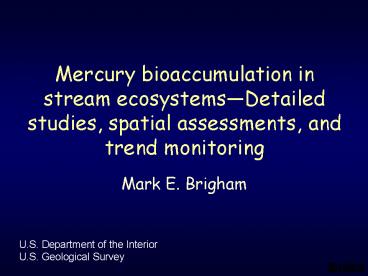Mercury bioaccumulation in stream ecosystems - PowerPoint PPT Presentation
1 / 23
Title:
Mercury bioaccumulation in stream ecosystems
Description:
... Dennis Wentz Sources anthropogenic and natural Hg Hg+2 MeHg Methylation Hg Hg+2 Biomagnification PHg (particulate Hg) PHg Sed. Hg Hg ... – PowerPoint PPT presentation
Number of Views:313
Avg rating:3.0/5.0
Title: Mercury bioaccumulation in stream ecosystems
1
Mercury bioaccumulation in stream
ecosystemsDetailed studies, spatial assessments,
and trend monitoring
- Mark E. Brigham
U.S. Department of the Interior U.S. Geological
Survey
2
What drives mercury bioaccumulation in stream
ecosystems?
3
Mercury cycling is interrelated with numerous
environmental issues
Hydrology Aquatic chemistry Atmospheric
chemistry Ecological function Land
cover/land use
4
In aquatic ecosystems, mercury runoff may be
- Increased by
- Erosion weathering of soils
- Low-intensity fires?
- Urbanization increase in impervious surfaces
- Increased inputs
- Decreased by
- Soil restorative processes
- Intense fires
- Decreased inputs
5
Notes related to previous slide, including
selected references page 1 of 2
- Soil erosion and increased Hg runoff
- (See Balogh et al., 1997, Environ. Sci.
Technol., v 31, p. 198 Balogh et al., 1998,
Environ. Sci. Technol., v 32, p. 456 Balogh et
al., 2000, J. Environ. Qual., v 29, p. 871). - Fires and mercury runoff The effect of fires is
likely complex, temporally dynamic, and likely
depends on more environmental variables than can
be summarized herein. Fire likely affects both
mercury speciation and total mercury
concentration in runoff. Low-intensity fires may
promote runoff of higher methylmercury
concentrations (see Amirbahman et al., 2004,
Water, Air, Soil Pollut., v 152, p. 313),
possibly due to enhanced methylation. Hotter
fires volatilize mercury (Sigler et al., 2003,
Environ. Sci. Technol., v 37, p. 4343 Cannon
W.F. et al., 2002, Geological Society of America
Annual Meeting, Oct. 22-27, 2002,
http//gsa.confex.com/gsa/2002AM/finalprogram/abst
ract_40419.htm), and may affect mercury
bioaccumulation (Garcia Carignan, 1999, Can. J.
Fish. Aquat. Sciences, v 56, p. 339). More
research is needed to describe the role of fire
on mercury runoff and speciation.
6
Notes related to previous slide, including
selected references page 2 of 2
- Mercury runoff and urbanization (See Mason and
Sullivan, 1998, Water Resources, v 32, p.
321-330) - Mercury runoff and soil restorative processes
This argument is the converse of the above notes
on erosion processes that exacerbate mercury
runoff. Soil erosion increases mercury runoff to
aquatic ecosystems controlling erosion in a
highly erodible setting would tend to decrease
mercury runoff. Also, soil organic carbon holds
a large reservoir of mercury at the earths
surface. Mineralization of this soil organic
matter is exacerbated with many land use and
intensive cultivation practices, implying
potential for release and runoff of soil-bound
mercury. Conversely, conservation-minded land use
and cultivation practices can restore soil
organic matter (Tilman, Nature 1998, v 396, p.
211), implying potential for retention of
atmospherically deposited mercury on the land
surface.
7
Erosion mobilizes mercury and carbon from soils
to natural waters.
8
Numerous influences alter methylation
- New impoundments (reservoirs, wetlands)
- Cycles of wetting and drying
- Sulfur recycling
- Sulfate loading
- Temperature
9
Consider mercury in resource management
decisions particularly in ecosystems with
mercury advisories
- Wealth of expertise to inform ecosystem
management. - Existing literature
- New research
- Adaptive management
10
Mercury bioaccumulation in stream
ecosystemsDetailed studies
- Barb Scudder
- Lia Chasar
- Dennis Wentz
- Mark Brigham
- Rod DeWeese
- Amanda Bell
- Michelle Lutz
- Dave Krabbenhoft
- Mark Marvin-DiPasquale
- George Aiken
- Carol Kendall
- Robin Stewart
- Bill Orem
- Others
- NAWQA Program
- Toxic Substances Hydrology Program
- National Research Program
- Geology
- Biological Resources
- And USEPA
11
Detailed mercury studies(USGS-NAWQA study areas)
Willamette Basin
Western Lake Michigan Drainages
Hudson River Basin
Long Island-New Jersey
Lake Erie Basin
Santee Basin
Georgia-Florida Coastal Plain
Reference stream
Urban stream
12
Urban settings
Photos Dennis Wentz
13
Relative reference settingsrange from
high-topographic gradient / low organic carbon
streams
14
to low-topographic gradient, high-carbon streams
15
Detailed studies
- Urban sites
- Presumed higher loading proximity to many
sources - Not targeted to point sources!
- Enhanced runoff
- Disturbed ecosystems
- Undisturbed rural sites
- Low-moderate Hg loading
- Not negative control for urban sites
- Natural runoff pathways
- Undisturbed ecosystems
16
Sources anthropogenic and natural
Hgº Hg2
Hgº Hg2 MeHg
PHg (particulate Hg)
PHg
Methylation
Sed. Hg
Biomagnification
Hgº Hg2 MeHg
Hg2 MeHg
17
Food web sampling
18
River mercury studies model development
- Start simple
Intensive study area
Modified from Reed Harris, Tetra Tech Inc.
19
River mercury studies model development
- Build complexity over time
Intensive study area
Modified from Reed Harris, Tetra Tech Inc.
20
Spatial assessmentsNational synoptic for mercury
- One-time, multimedia sampling of streams
- Spatial coverage diverse settings
- Correlative analysis (biogeochemical spatial)
- Refs
http//toxics.usgs.gov/pubs/wri99-4018/Volume2/sec
tionB/2301_Krabbenhoft/pdf/2301_Krabbenhoft.pdf ht
tp//www.cerc.usgs.gov/pubs/center/pdfdocs/BSR2001
-0009.pdf
21
USGS national mercury synoptic
Streams sampling in most NAWQA study areas, in
1998, 2002, 2004-05
USGS NAWQA Program
22
Trends
- A national network of multimedia Hg-trend sites
to assess ecosystem responses to emission
reductions in - Precipitation (MDN)
- Surface water
- Fish
- Contact Mark Brigham
- (mbrigham_at_usgs.gov)
23
Summary
- USGS is studying methylmercury in key components
of stream ecosystems, at selected sites across
the nation. - several temporal and spatial scales
- Detailed studies
- Spatial (synoptic) assessments
- Trend sampling































